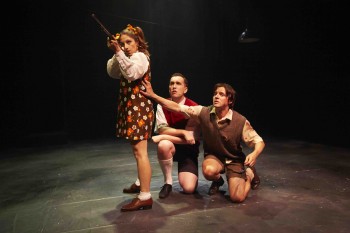Manilla Street: Blood Brothers
Blood Brothers revolves around a pair of twins, Mickey and Edward, who are separated from birth. The children’s lives are told through the frame of a series of collisions between binary opposites starting when their mother, Mrs Johnstone, cannot afford to keep both boys and gives Edward away to Mrs Lyons, her wealthy employer.

The story progresses as both boys chance upon one another again and again, much to the dismay of both mothers, who want to keep the truth away from their children. It is the polar opposites between both sides of the economic scale that make for a commentary on social status; how the opportunities given to one and denied to another are based on fortune and chance.
The design is minimalistic, favouring simple shapes that cut through the space on angles. This feels inventive and original, opening the space and encompassing the three-piece band, who skilfully render a difficult score.
Unfortunately, the choreography fell short, lacking both energy and precision and drawn out pauses between lines and scenes meant that the emotional ebb and flow of the performance fell flat. The result was that key moments became melodramatic, insensitive or comic and there was little sympathy felt for any of the characters. With the exception of key comic moments of innocence from Gareth Keegan and Matthew Bradford as the twins Mickey and Eddie, as well as Glenda Linscott, who succeeds in portraying the radical and unexpected shifts in her character.
The show itself deals with extremely powerful emotions, themes of maternal and familial love. However, the writing suffers from clichéd dialogue and convoluted plot twists: moving from themes and events surrounding motherhood, adoption, superstition and the church, economic disparity, growing up, childhood expectations, depression, teenage love, the 1980s the Irish recession, prison life and murder. Indeed, the it covers such a broad spectrum of social and personal issues that nothing is examined and the performance becomes a shallow notation of events within multiple lives.
Ultimately, the piece is pulled off by the skill and ability of the actors, whose commitment to the work is strong. However, pacing issues and the unsatisfying plot distract from the overall experience.

